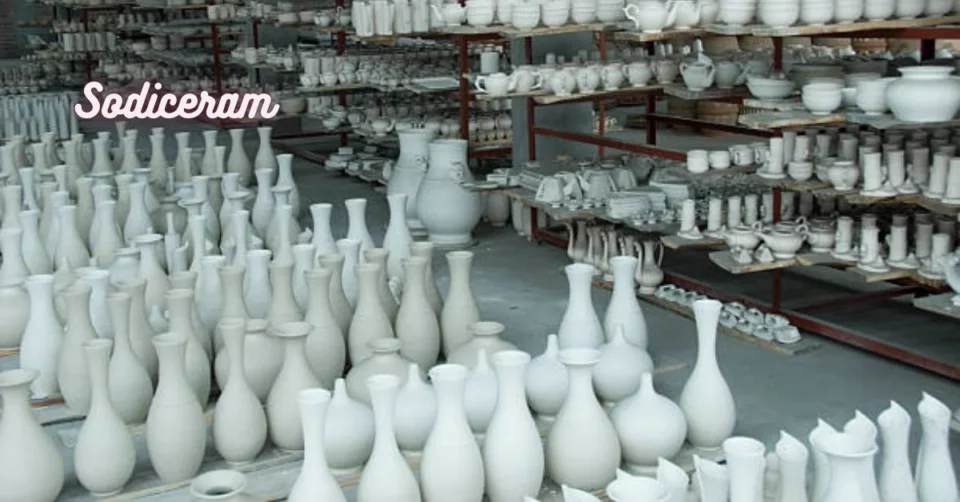Imagine a world where the beauty and functionality of ceramics meet sustainability head-on. Enter Sodiceram—a revolutionary approach to ceramic materials that harnesses the power of sodium. This innovative twist on traditional ceramics not only promises enhanced performance but also paves the way for a greener future. With growing concerns about environmental impact, Sodiceram stands out as a beacon of hope in an industry often criticized for its ecological footprint. Let’s explore what makes this material so unique and how it is set to transform various sectors while benefiting our planet.
Introducing Sodiceram: What is it and how does it work?
This advanced ceramic, known as Sodiceram, is uniquely engineered with sodium as a primary element. Unlike traditional ceramics, which often rely on silica and aluminum, Sodiceram utilizes sodium-based compounds to create a unique matrix. This shift not only alters the structural properties but also enhances overall performance.
The process begins with sourcing natural minerals rich in sodium. These materials are then processed and shaped into desired forms before undergoing high-temperature firing. The result is a durable ceramic product that retains impressive mechanical strength while being lightweight.
What sets Sodicerams apart is its ability to be tailored for specific applications. By adjusting the composition, manufacturers can produce variants suited for different industries—from construction to electronics—without compromising sustainability or quality.
The Environmental Impact of Traditional Ceramics
Traditional ceramics have long been a staple in various industries, but their environmental impact often goes unnoticed. The production process typically involves high-temperature firing and substantial energy consumption. This not only contributes to greenhouse gas emissions but also depletes non-renewable resources.
Additionally, mining for raw materials like clay and feldspar can lead to habitat destruction and soil degradation. Water usage is another critical concern; ceramic manufacturing consumes significant amounts of water, straining local resources.
Once manufactured, traditional ceramics may not be easily recyclable or biodegradable. Their durability means they can linger in landfills for thousands of years after disposal.
The cumulative effects of these practices raise important questions about sustainability. As the world seeks greener alternatives, it’s clear that traditional methods cannot continue without serious consequences for our planet’s future.
How Sodiceram is Changing the Game?
Sodiceram is revolutionizing the ceramics industry with its innovative sodium-based technology. Unlike traditional ceramics, which often rely on energy-intensive materials and processes, Sodiceram offers a more sustainable solution.
This new approach utilizes sodium-rich raw materials that are abundant and eco-friendly. The production process requires less energy, significantly reducing carbon emissions compared to conventional methods.
Moreover, Sodiceram boasts exceptional durability and versatility. Its unique properties make it suitable for various applications across industries—from construction to electronics.
As manufacturers embrace this breakthrough material, we may see a shift in how products are designed and produced. This transition paves the way for greener practices without sacrificing quality or functionality.
The potential of Sodiceram extends far beyond what we currently imagine, making it an exciting development in our pursuit of sustainability.
Advantages of Using Sodiceram
With numerous standout benefits, Sodiceram clearly outperforms standard ceramic materials. First, its sodium-based composition allows for lower energy consumption during production. As a result, greenhouse emissions drop significantly, leading to a more eco-friendly footprint.
Another notable benefit is the enhanced durability of Sodiceram products. They exhibit remarkable resistance to thermal shock and mechanical stress, making them ideal for demanding environments.
Sodiceram also boasts excellent versatility in design and application. Manufacturers can easily mold it into various shapes and sizes without compromising quality. This flexibility opens doors for innovative solutions across multiple industries.
Additionally, the eco-friendly nature of Sodicerams appeals to environmentally conscious consumers and businesses alike. It aligns with global sustainability goals, promoting responsible manufacturing practices while delivering high-performance materials.
Using Sodiceram can lead to cost savings over time due to its longevity and low maintenance requirements.
Applications of Sodiceram in Different Industries
Thanks to its unique qualities, Sodiceram is rapidly gaining traction in multiple sectors. In the construction sector, it serves as an eco-friendly alternative to traditional ceramic materials. Being exceptionally light, it helps cut shipping expenses and lowers overall energy use.
In electronics, Sodiceram’s thermal stability makes it ideal for insulators and substrates in circuit boards. This enhances performance while minimizing environmental impact.
Car manufacturers gain from Sodiceram’s strong, heat-resistant properties, making it ideal for demanding automotive applications. It’s increasingly used in components that require high-temperature resilience without compromising sustainability.
Even in healthcare, innovative applications are emerging. Sodicerams can be utilized for creating biocompatible implants or dental restorations, promoting a greener approach to medical solutions.
Artisans are exploring its artistic potential as well, crafting unique pieces that blend creativity with environmental responsibility. Each industry finds new ways to harness the benefits of this groundbreaking material.
Future Possibilities and Potential for Growth
Sodiceram’s future holds countless innovative opportunities and groundbreaking advancements. As industries look for sustainable alternatives, the demand for sodium-based ceramics will likely surge.
Research and development are paving new avenues. Innovations in production methods could enhance performance while reducing costs. This means more accessible options for manufacturers worldwide.
The adaptable nature of Sodicerams enables it to serve a wide range of purposes that go far beyond conventional ceramic uses. From construction materials to advanced electronics, the potential markets are vast and diverse.
Collaboration with eco-conscious brands can amplify growth opportunities. Together, they can create solutions that not only meet consumer needs but also prioritize environmental responsibility.
As awareness about sustainability increases, Sodicerams stands at a pivotal point in its journey. Its unique properties may redefine standards across multiple sectors and inspire further advancements in green technology.
Conclusion: Embracing Sodiceram for a Sustainable Future
Sodiceram represents a significant shift in the ceramics industry. By leveraging sodium-based materials, it opens the door to greener manufacturing processes and reduced environmental impacts. As industries increasingly prioritize sustainability, Sodiceram stands out as a viable alternative to traditional ceramics.
The advantages of using Sodiceram are compelling. From lower energy consumption during production to enhanced recyclability, its benefits extend far beyond mere functionality. The potential applications across diverse sectors—from construction to electronics—demonstrate versatility that could reshape how we think about ceramic materials.
As research continues and technology evolves, the future possibilities for Sodicerams appear bright. Its adoption could lead not only to improved product performance but also meaningful contributions toward global sustainability goals.
Embracing this innovative material may be key to fostering a healthier planet for generations to come. It invites us all—manufacturers, consumers, and innovators—to consider new pathways toward reducing our ecological footprint while still enjoying the durability and beauty that ceramics provide.
For those who crave insight, Vehicle DART is your cozy corner of curiosity.

